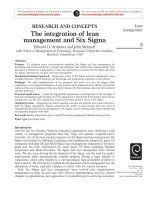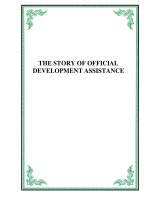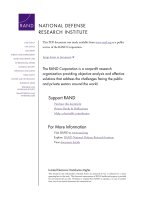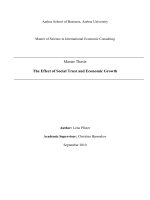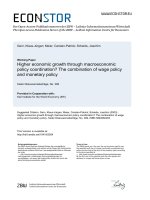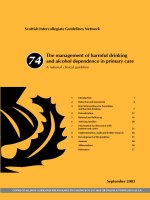Simulation the practice of model development and use
Bạn đang xem bản rút gọn của tài liệu. Xem và tải ngay bản đầy đủ của tài liệu tại đây (3.15 MB, 339 trang )
Simulation: The Practice of Model
Development and Use
Stewart Robinson
Warwick Business School
Simulation: The Practice of Model
Development and Use
Simulation: The Practice of Model
Development and Use
Stewart Robinson
Warwick Business School
Copyright 2004 John Wiley & Sons Ltd, The Atrium, Southern Gate, Chichester,
West Sussex PO19 8SQ, England
Telephone (+44) 1243 779777
Email (for orders and customer service enquiries):
Visit our Home Page on www.wileyeurope.com or www.wiley.com
All Rights Reserved. No part of this publication may be reproduced, stored in a retrieval system or transmitted in
any form or by any means, electronic, mechanical, photocopying, recording, scanning or otherwise, except under
the terms of the Copyright, Designs and Patents Act 1988 or under the terms of a licence issued by the Copyright
Licensing Agency Ltd, 90 Tottenham Court Road, London W1T 4LP, UK, without the permission in writing of
the Publisher. Requests to the Publisher should be addressed to the Permissions Department, John Wiley & Sons
Ltd, The Atrium, Southern Gate, Chichester, West Sussex PO19 8SQ, England, or emailed to
, or faxed to (+44) 1243 770620.
This publication is designed to provide accurate and authoritative information in regard to the subject matter
covered. It is sold on the understanding that the Publisher is not engaged in rendering professional services. If
professional advice or other expert assistance is required, the services of a competent professional should be
sought.
Other Wiley Editorial Offices
John Wiley & Sons Inc., 111 River Street, Hoboken, NJ 07030, USA
Jossey-Bass, 989 Market Street, San Francisco, CA 94103-1741, USA
Wiley-VCH Verlag GmbH, Boschstr. 12, D-69469 Weinheim, Germany
John Wiley & Sons Australia Ltd, 33 Park Road, Milton, Queensland 4064, Australia
John Wiley & Sons (Asia) Pte Ltd, 2 Clementi Loop #02-01, Jin Xing Distripark, Singapore 129809
John Wiley & Sons Canada Ltd, 22 Worcester Road, Etobicoke, Ontario, Canada M9W 1L1
Wiley also publishes its books in a variety of electronic formats. Some content that appears
in print may not be available in electronic books.
Library of Congress Cataloging-in-Publication Data
Robinson, Stewart, 1964-
Simulation : the practice of model development and use / Stewart Robinson.
p. cm.
Includes bibliographical references and index.
ISBN 0-470-84772-7 (pbk.)
1. Computer simulation. 2. Simulation methods. I. Title.
QA76.9.C65R63 2003
003
.3 – dc22
2003063093
British Library Cataloguing in Publication Data
A catalogue record for this book is available from the British Library
ISBN 0-470-84772-7
Typeset in 10/12pt Goudy by Laserwords Private Limited, Chennai, India
Printed and bound in Great Britain by Biddles Ltd, Guildford and King’s Lynn
This book is printed on acid-free paper responsibly manufactured from sustainable forestry
in which at least two trees are planted for each one used for paper production.
For Jane, Naomi, Martha and Aaron
C ONTENTS
ACKNOWLEDGEMENTS xv
PREFACE xvii
CHAPTER 1
www.simulation: What, Why and When? 1
1.1 Introduction 1
1.2 Whatissimulation? 2
1.3 Why simulate? 4
1.3.1 The nature of operations systems: variability,
interconnectedness and complexity 4
1.3.2 The advantages of simulation 8
1.3.3 The disadvantages of simulation 10
1.4 When to simulate 11
1.5 Conclusion 11
Exercises 12
References 12
CHAPTER 2
Inside Simulation Software 13
2.1 Introduction 13
2.2 Modelling the progress of time 13
2.2.1 The time-slicing approach 14
2.2.2 The discrete-event simulation approach
(three-phase method) 15
2.2.3 The continuous simulation approach 24
2.2.4 Summary: modelling the progress of time 26
2.3 Modelling variability 26
2.3.1 Modelling unpredictable variability 26
[ viii ]
C ONTENTS
2.3.2 Random numbers 26
2.3.3 Relating random numbers to variability in a simulation 27
2.3.4 Modelling variability in times 27
2.3.5 Sampling from standard statistical distributions 30
2.3.6 Computer generated random numbers 31
2.3.7 Modelling predictable variability 33
2.3.8 Summary on modelling variability 33
2.4 Conclusion 33
Exercises 34
References 35
CHAPTER 3
Software for Simulation 37
3.1 Introduction 37
3.2 Visual interactive simulation 38
3.3 Simulation software 39
3.3.1 Spreadsheets 39
3.3.2 Programming languages 40
3.3.3 Specialist simulation software 40
3.3.4 Comparing spreadsheets, programming languages and specialist
simulation software 41
3.4 Selection of simulation software 43
3.4.1 The process of software selection 43
3.4.2 Step 1: Establish the modelling requirements 44
3.4.3 Step 2: Survey and shortlist the software 44
3.4.4 Step 3: Establish evaluation criteria 44
3.4.5 Step 4: Evaluate the software in relation to the criteria 45
3.4.6 Step 5: Software selection 46
3.5 Conclusion 47
References 48
CHAPTER 4
Simulation Studies: An Overview 51
4.1 Introduction 51
4.2 Simulation studies: an overview of key modelling processes 51
4.2.1 Simulation modelling is not linear 54
4.2.2 Something is missing! 55
4.3 Simulation project time-scales 56
4.4 The simulation project team 57
4.5 Hardware and software requirements 58
4.6 Project costs 59
4.7 Project selection 60
4.8 Conclusion 61
References 61
[ ix ]
C ONTENTS
CHAPTER 5
Conceptual Modelling 63
5.1 Introduction 63
5.2 Conceptual modelling: important but little understood 63
5.3 What is a conceptual model? 65
5.4 Requirements of the conceptual model 66
5.4.1 Four requirements of a conceptual model 66
5.4.2 Keep the model simple 68
5.5 Communicating the conceptual model 69
5.5.1 Simulation project specification 69
5.5.2 Representing the conceptual model 71
5.6 Conclusion 74
Exercise 74
References 74
CHAPTER 6
Developing the Conceptual Model 77
6.1 Introduction 77
6.2 A Framework for conceptual modelling 77
6.2.1 Developing an understanding of the problem situation 78
6.2.2 Determining the modelling objectives 80
6.2.3 Designing the conceptual model: the inputs and outputs 82
6.2.4 Designing the conceptual model: the model content 83
6.2.5 The role of data in conceptual modelling 85
6.2.6 Summary of the conceptual modelling framework 86
6.3 Methods of model simplification 87
6.3.1 Aggregation of model components 88
6.3.2 Excluding components and details 89
6.3.3 Replacing components with random variables 89
6.3.4 Excluding infrequent events 90
6.3.5 Reducing the rule set 90
6.3.6 Splitting models 90
6.3.7 What is a good simplification? 91
6.4 Conclusion 92
Exercises 92
References 93
CHAPTER 7
Data Collection and Analysis 95
7.1 Introduction 95
7.2 Data requirements 95
7.3 Obtaining data 97
7.3.1 Dealing with unobtainable (category C) data 98
[ x ]
C ONTENTS
7.3.2 Data accuracy 99
7.3.3 Data format 99
7.4 Representing unpredictable variability 100
7.4.1 Traces 100
7.4.2 Empirical distributions 101
7.4.3 Statistical distributions 102
7.4.4 Traces versus empirical distributions versus statistical distributions . 107
7.4.5 Bootstrapping 110
7.4.6 Further issues in representing unpredictable variability: correlation
and non-stationary data 110
7.5 Selecting statistical distributions 111
7.5.1 Selecting distributions from known properties of the process 112
7.5.2 Fitting statistical distributions to empirical data 112
7.6 Conclusion 121
Exercises 121
References 124
CHAPTER 8
Model Coding 127
8.1 Introduction 127
8.2 Structuring the model 127
8.3 Coding the model 128
8.3.1 Separate the data from the code from the results 129
8.3.2 Use of pseudo random number streams 130
8.4 Documenting the model and the simulation project 133
8.5 Conclusion 135
Exercises 136
References 136
CHAPTER 9
Experimentation: Obtaining Accurate Results 137
9.1 Introduction 137
9.2 The nature of simulation models and simulation output 137
9.2.1 Terminating and non-terminating simulations 138
9.2.2 Transient output 138
9.2.3 Steady-state output 138
9.2.4 Other types of output 140
9.2.5 Determining the nature of the simulation output 140
9.3 Issues in obtaining accurate simulation results 141
9.3.1 Initialization bias: warm-up and initial conditions 141
9.3.2 Obtaining sufficient output data: long runs and multiple replications 142
9.4 An example model: computer user help desk 142
9.5 Dealing with initialization bias: warm-up and initial conditions 143
9.5.1 Determining the warm-up period 143
[ xi ]
C ONTENTS
9.5.2 Setting initial conditions 150
9.5.3 Mixed initial conditions and warm-up 150
9.5.4 Initial conditions versus warm-up 151
9.6 Selecting the number of replications and run-length 151
9.6.1 Performing multiple replications 152
9.6.2 Variance reduction (antithetic variates) 157
9.6.3 Performing a single long run 159
9.6.4 Multiple replications versus long runs 162
9.7 Conclusion 163
Exercises 163
References 167
CHAPTER 10
Experimentation: Searching the Solution Space 169
10.1 Introduction 169
10.2 The nature of simulation experimentation 171
10.2.1 Interactive and batch experimentation 171
10.2.2 Comparing alternatives and search experimentation 172
10.3 Analysis of results from a single scenario 173
10.3.1 Point estimates 173
10.3.2 Measures of variability 176
10.4 Comparing alternatives 177
10.4.1 Comparison of two scenarios 178
10.4.2 Comparison of many scenarios 180
10.4.3 Choosing the best scenario(s) 183
10.5 Search experimentation 183
10.5.1 Informal approaches to search experimentation 184
10.5.2 Experimental design 186
10.5.3 Metamodelling 190
10.5.4 Optimization (‘‘searchization’’) 192
10.6 Sensitivity analysis 194
10.7 Conclusion 195
Exercises 196
References 198
CHAPTER 11
Implementation 201
11.1 Introduction 201
11.2 What is implementation? 201
11.2.1 Implementing the findings 201
11.2.2 Implementing the model 202
11.2.3 Implementation as learning 203
11.3 Implementation and simulation project success 203
11.3.1 What is simulation project success? 204
[ xii ]
C ONTENTS
11.3.2 How is success achieved? 204
11.3.3 How is success measured? 206
11.4 Conclusion 207
References 207
CHAPTER 12
Verification, Validation and Confidence 209
12.1 Introduction 209
12.2 What is verification and validation? 209
12.3 The difficulties of verification and validation 212
12.3.1 There is no such thing as general validity 213
12.3.2 There may be no real world to compare against 213
12.3.3 Which real world? 213
12.3.4 Often the real world data are inaccurate 213
12.3.5 There is not enough time to verify and validate everything 214
12.3.6 Confidence not validity 214
12.4 Methods of verification and validation 214
12.4.1 Conceptual model validation 214
12.4.2 Data validation 215
12.4.3 Verification and white-box validation 215
12.4.4 Black-box validation 217
12.4.5 Experimentation validation 220
12.4.6 Solution validation 220
12.5 Independent verification and validation 221
12.6 Conclusion 222
Exercises 223
References 224
CHAPTER 13
The Practice of Simulation 227
13.1 Introduction 227
13.2 Types of simulation model 227
13.3 Modes of simulation practice 230
13.3.1 Three modes of practice 230
13.3.2 Facets of the modes of simulation practice 231
13.3.3 Modes of practice in business and the military 233
13.4 Conclusion 235
References 235
APPENDIX 1: Wardeon Cinema 237
APPENDIX 2: Panorama Televisions 259
APPENDIX 3: Methods of reporting simulation results 279
[ xiii ]
C ONTENTS
APPENDIX 4: Statistical distributions 289
APPENDIX 5: C ritical values for the chi-square test 301
APPENDIX 6: Critical values for the Student’s t-distribution 303
Index 305
A CKNOWLEDGEMENTS
Various people have offered advice and reviewed sections and chapters of the book during
its writing. In particular I would like to thank (in alphabetical order) Russell Cheng, Ruth
Davies, Geoff Hook, Maureen Meadows and Durk-Jouke van der Zee.
P REFACE
It was in the mid-1980s that I stumbled upon a career in simulation modelling, a career
that can be split roughly into two parts. In the first part I spent my time as an external
consultant, developing and using simulations for manufacturing and service organizations,
and training and supporting simulation users. At first the simulations were developed in a
programming language. Later I was able to take advantage of more user-friendly simulation
software. The second part of my career has largely been spent reflecting upon my time
as a consultant and researching the way in which others practise simulation. I also teach
simulation to undergraduates, postgraduates and industrialists, and occasionally find time
to do a little consulting, keeping fresh those memories of the first part of my career. Over
this period a wide range of lessons has been learnt, revealing ‘‘the good, the bad and the
ugly’’ of simulation practice. It is these lessons that are described in the pages that follow.
The aim of this book is to provide the reader with a clear understanding of the
requirements for the successful development and use of simulation models. The specific
objectives of the book are for the reader:
ž
To understand how simulation software works and the types of software that are available
for simulation modelling.
ž
To know the processes involved in a simulation project.
ž
To be able to develop an appropriate model for a problem situation.
ž
To be able to collect and analyse the data required for a simulation model.
ž
To be able to perform simulation experiments, analyse the results and draw conclusions.
ž
To ensure that a simulation model has been verified and validated so there is sufficient
confidence to use the model in decision-making.
ž
To know how to manage a simulation project successfully.
The assumption is that the reader has access to, and some level of competence with, a
simulation software package. In this respect the book takes a non-software specific view
and so should be useful whatever software is being used. Indeed, almost all the principles
and techniques described apply to the use of non-specialist simulation software (e.g.
programming languages and spreadsheets) as well.
[ xviii ]
P REFACE
At whom is this book aimed? In short, to anyone who has a problem that needs to be
tackled with simulation. Who is anyone? Undergraduates and postgraduates who are learning
about the principles of simulation, particularly from the perspective of how to investigate
a problem with a simulation model. My observation is that most simulation courses now
ask students to tackle a (pseudo-) real problem as part of the assessment. Meanwhile, some
students are asked to take on larger-scale problems as part of a practical or research project.
Both should find this book useful. Beyond those in education, practitioners, both novice
and longer-in-the-tooth, who are trying to develop and hone their simulation skills should
also benefit from the content of this book.
What types of problems are we considering? In summary, those that relate to operations
systems. These systems are described in Section 1.2. For now it is enough to say that the
hub of almost any organization is its operations systems. Included in this description are
manufacturing systems, service systems, health care systems, transportation systems, business
processes, military operations and many more. As such, the focus is on simulation as it
is used in operational (or operations) research. The underlying simulation method most
commonly used in this field is discrete-event simulation (Section 2.2.2), although many of
the ideas presented in this book could be applied to other methods of simulation.
The practice of simulation requires both technical and socio-political skills. Indeed, a mix
of skills is needed including problem solving, computing, statistics, project management,
people management and communication. It has been my aim to describe the core skills
required for the successful application of simulation, while at the same time not giving
undue emphasis to any one area. Although some give great emphasis to, say, the computing
or statistical aspects of simulation, and rightly so within a specific context, my contention is
that successful simulation studies require well-rounded modellers whose skills lie across the
range of areas listed above. Of course, some may wish to delve into specific areas in more
depth. It is hoped that the references provided at the end of each chapter will provide a
starting point for such investigations.
The first three chapters provide a background to simulation and simulation software.
Chapter 1 explains what simulation is, why it would be used and the sorts of applications
to which it might be applied. Chapter 2 then goes on to describe how simulation software
works. Two specific areas are discussed: modelling the progress of time and modelling
variability. Meanwhile, Chapter 3 describes the different types of simulation software and
the selection of an appropriate package.
Following this introduction to simulation the attention turns to the process of performing
a simulation study: the main content of the book. Chapter 4 provides an outline of this
process and discusses the issues surrounding project time-scales, the simulation project
team, hardware and software requirements, project costs and the selection of projects. In the
outline of a simulation study, four key processes are identified: conceptual modelling, model
coding, experimentation and implementation. These processes are described in detail in
Chapters 5 to 11.
Chapters 5 and 6 explain the requirements for and process of conceptual modelling. The
role of a ‘‘project specification’’ is explained and some methods for simplifying simulation
models are also described. Chapter 7 discusses data requirements, and data collection and
[ xix ]
P REFACE
analysis. Various methods for representing variability are described and the identification of
an appropriate method is discussed. Chapter 8 focuses on the coding of the simulation model.
Chapters 9 and 10 explain the process of experimentation. The focus of Chapter 9 is on
obtaining accurate results by ensuring that the simulation has been run for long enough.
Meanwhile, methods for searching for improvements to the system being simulated are
described in Chapter 10. The fourth process, implementation, is discussed in Chapter 11.
Up to this point there is little mention of the verification and validation of the simulation
model. This subject is left to Chapter 12 where the need continuously to perform verification
and validation throughout a simulation study is highlighted. The difficulties encountered
in validating models are discussed and methods of verification and validation are described.
The final chapter (Chapter 13) discusses the practice of simulation in terms of simulation
model types and the way in which simulation models are developed and used.
In Appendix 1 and 2, two case study examples are presented: Wardeon Cinema and
Panorama Televisions. The purpose of these examples is to provide an illustration of how
the principles and techniques described in the book can be applied to semi-real problems.
The reader is encouraged to follow these examples and possibly to develop and use models
of each case in order to gain practice with simulation.
Exercises are given at the end of many of the chapters. These are intended to give
the reader practice with the concepts presented in a chapter and to encourage some
further investigation into important areas. A web site (www.wileyeurope.com/go/robinson
)
provides data for the exercises and Excel spreadsheets for some of the analytical methods
presented in the book. It also provides simulation models for the Wardeon Cinema and
Panorama Televisions cases (Appendix 1 and 2). These have been developed in various
simulation software packages.
Stewart Robinson
July 2003
